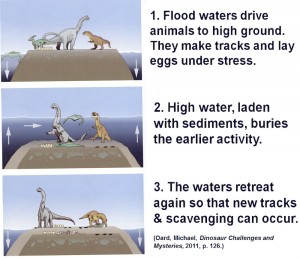Trace Fossils & Eggs – Part 3
 In recent months we have discussed the vast number of dinosaur trace fossils preserved in rock layers. One of the challenges for the Flood model is that there are places where trace fossils, especially footprints, are found on top of very thick sediment layers. Sometimes tracks and nests are found at multiple rock levels in the same location. Evolutionists point to these and say, “How can dinosaurs survive the inundation of the Flood waters? It’s not possible for them to still be walking around and laying eggs down there underwater as those upper Flood layers form!” Creationist Michael Oard has proposed a Flood model involving Briefly Exposed Diluvial Sediments (BEDS) to explain the data. His hypothesis is that alternatively rising and lowering flood waters, coupled with rapid sedimentation during the Genesis Flood best explains these features. It is quite reasonable that tectonic activity, meteorite impacts, and tidal forces would create oscillating water levels, allowing dinosaurs to swim during high water times and then resume walking and depositing eggs (see the picture above). Fossilized dinosaur nesting sites are now recognized from about 200 locations worldwide. But there is typically no vegetation preserved around these egg clutches. Eggs appear to be laid directly on a sandy beach or mud flat without proper nest structures. This is uncommon behavior for reptiles, who typically bury their porous eggs in the ground or under vegetation to maintain humidity and to hide them. Some of the fossil dinosaur egg shells are also multi-layered, evidence of dinosaur mothers being forced to lay eggs under stressful conditions. This actually fits the Flood scenario quite well.
In recent months we have discussed the vast number of dinosaur trace fossils preserved in rock layers. One of the challenges for the Flood model is that there are places where trace fossils, especially footprints, are found on top of very thick sediment layers. Sometimes tracks and nests are found at multiple rock levels in the same location. Evolutionists point to these and say, “How can dinosaurs survive the inundation of the Flood waters? It’s not possible for them to still be walking around and laying eggs down there underwater as those upper Flood layers form!” Creationist Michael Oard has proposed a Flood model involving Briefly Exposed Diluvial Sediments (BEDS) to explain the data. His hypothesis is that alternatively rising and lowering flood waters, coupled with rapid sedimentation during the Genesis Flood best explains these features. It is quite reasonable that tectonic activity, meteorite impacts, and tidal forces would create oscillating water levels, allowing dinosaurs to swim during high water times and then resume walking and depositing eggs (see the picture above). Fossilized dinosaur nesting sites are now recognized from about 200 locations worldwide. But there is typically no vegetation preserved around these egg clutches. Eggs appear to be laid directly on a sandy beach or mud flat without proper nest structures. This is uncommon behavior for reptiles, who typically bury their porous eggs in the ground or under vegetation to maintain humidity and to hide them. Some of the fossil dinosaur egg shells are also multi-layered, evidence of dinosaur mothers being forced to lay eggs under stressful conditions. This actually fits the Flood scenario quite well.
Posted on July 2, 2023 by dwoetzel.
